Method of fabricating nonvolatile semiconductor memory device
a nonvolatile, memory device technology, applied in the direction of semiconductor devices, basic electric elements, electrical appliances, etc., can solve the problems of difficult to form miniaturized cmos circuits with high performance and nonvolatile semiconductor memory devices on the same substrate, adversely affecting various impurity concentrations, etc., to suppress damage to tunnel insulation films and eliminate long heat treatment period
- Summary
- Abstract
- Description
- Claims
- Application Information
AI Technical Summary
Benefits of technology
Problems solved by technology
Method used
Image
Examples
embodiment 1
A Variation of Embodiment 1
Variation of Embodiment 1 of the present invention is explained in the following by referring to figures.
FIG. 3A to FIG. 3C are cross sectional views which show a process sequence for a method of fabricating a nonvolatile semiconductor memory device in a variation of Embodiment 1 of the present invention. In FIG. 3A to FIG. 3C, components that are the same as the components of FIG. 1A to FIG. 1C are denoted by the same reference numbers and symbols.
First, as shown in FIG. 3A, a p-type well 11A and an insulation film 12, in this order, are formed above a semiconductor substrate 11. Then, a film 13A for forming a tunnel insulation film composed of silicon oxide, a film 14A for forming a floating gate electrode of poly-silicon, a film 15A for forming a capacitor insulator film composed of silicon oxide or silicon nitride, and a film 16A for forming a control gate electrode of poly-silicon having about 70 nm film thickness are sequentially deposited on the ent...
embodiment 2
Variation of Embodiment 2 of the present invention is explained in the following by referring to figures.
FIG. 6A to FIG. 6C are cross sectional views which show a process sequence for the method of fabricating a nonvolatile semiconductor memory device in a variation of Embodiment 2 of the present invention. Here, one gate structure and ion injection adjustment film are used to explain general fabrication methods. Also, in FIG. 6A to FIG. 6C, components which are the same as the components of FIG. 4A to FIG. 4C are denoted by the same reference numerals and symbols.
A feature of this variation example is that the ion injection adjustment film is made by a multi-layer structure of silicon oxide and silicon nitride that are formed sequentially from the gate structure side.
First, as shown in FIG. 6A, a p-type well 11a is formed on a semiconductor substrate 11 composed of p-type silicon, and, then, a gate structure 17 composed of a tunnel insulation film 13, a floating gate electrode 14, ...
PUM
 Login to View More
Login to View More Abstract
Description
Claims
Application Information
 Login to View More
Login to View More - R&D
- Intellectual Property
- Life Sciences
- Materials
- Tech Scout
- Unparalleled Data Quality
- Higher Quality Content
- 60% Fewer Hallucinations
Browse by: Latest US Patents, China's latest patents, Technical Efficacy Thesaurus, Application Domain, Technology Topic, Popular Technical Reports.
© 2025 PatSnap. All rights reserved.Legal|Privacy policy|Modern Slavery Act Transparency Statement|Sitemap|About US| Contact US: help@patsnap.com



